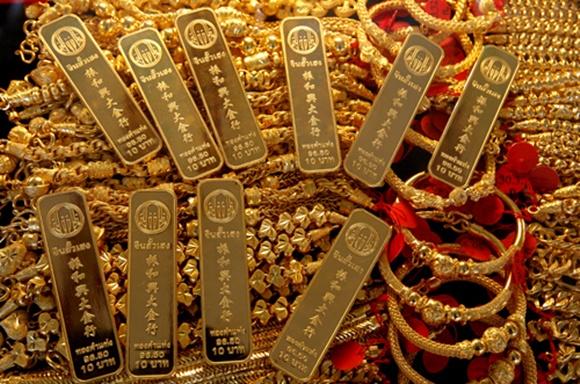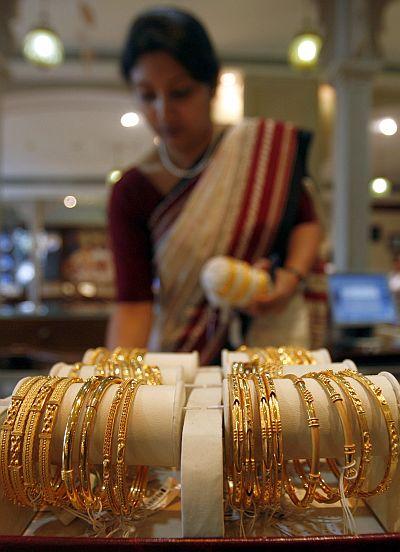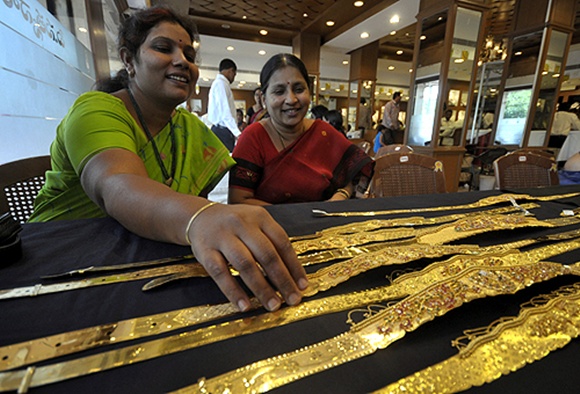 | « Back to article | Print this article |
Gold wins over realty as an investment option
India’s affection for gold has only been growing across rural and urban areas.
When compared with real estate, the yellow metal is still clearly perceived as a safer bet, a recent National Sample Survey Office survey revealed.
The share of expenditure on gold has risen sharply in both rural and urban parts of the country between 2004-05 and 2011-12, the survey shows.
On the other hand, the spending trend on real estate in this duration has revealed that the proportionate share of expenditure on residential buildings was down by almost half.
Please click NEXT to read further. . .
Gold wins over realty as an investment option
In rural parts, a person who used to spend 13.8 per cent of his total durable goods expenditure on gold in 2004-05 shelled out 23.6 per cent in 2011-12.
A similar trend was visible in the spending patterns of their urban counterparts.
An urban citizen spent 19.9 per cent of his/her total durable goods spending on gold in 2011-12, steeply up from 11.5 per cent in 2004-05.
This data was captured by NSSO’s 68th Round, titled 'Household consumption of various goods and services in India', released recently.
Please click NEXT to read further. . .
Gold wins over realty as an investment option
On residential buildings, people in rural areas diverted 18.1 per cent of their total spending on durable goods in 2011-12, steeply down from 33.4 per cent in 2004-05.
In urban areas, 11.4 per cent of this expenditure was on housing, compared to 20.9 per cent in 2004-05.
In 2004-05, among the durable goods, the share of spending on buying a house was the highest but this was replaced by gold in rural parts, and motor cars and jeeps in cities in 2011-12.
Analysts note the phase between 2004-05 and 2011-12 was a ‘gold boom’ for the country and, hence, people chose to invest in gold.
Please click NEXT to read further. . .
Gold wins over realty as an investment option
“Till last year, the preference of Indian households has been to invest in gold as a saving option. As the cost of buying a property is high, people tend to spend less on it,” said Madan Sabnavis, chief economist at CARE Ratings.
In rural parts, Sabnavis explained, there was a lack of investment options and, hence, the proportionate share of expenditure on gold went up.
“Whereas in urban areas, inflation was one reason which led people to choose physical savings rather than the financial ones,” he added.
Analysts say gold is a commodity which Indians prefer to buy even with a small investment surplus.
Please click NEXT to read further. . .
Gold wins over realty as an investment option
“Real estate involves big money.
“In villages, during the harvest, if the crop is good and there is an investment surplus with farmers, they buy gold as people also have the tendency to utilise this yellow metal during occasions like marriage,” said Devendra Pant, chief economist, India Ratings.
Abheek Barua, chief economist at HDFC Bank, said the perception that gold will give a good investment return propelled people to go for the yellow metal.
This could be gauged by looking at how the prices of both real estate and gold went up during this period.
Please click NEXT to read further. . .
Gold wins over realty as an investment option
India Bullion and Jewellers Association data showed between 2004-05 and 2011-12, the annual price for gold surged by a little more than 300 per cent.
Real estate prices went up only by 20-50 per cent in various metro cities, data available with real estate analyst firm Propequity for 2008-2012 showed.
However, Barua said the trend has started reversing in the present scenario.
“Till 2012-13, gold was on a continuous bull-run and people caught on to that.
“In this phase, wealth investors advised households to go for gold, rather than equity bonds and other options.
“But the trend has started reversing from 2013-14 as gold prices crashed and it has taken a big hit on gold investment,” he argued.






